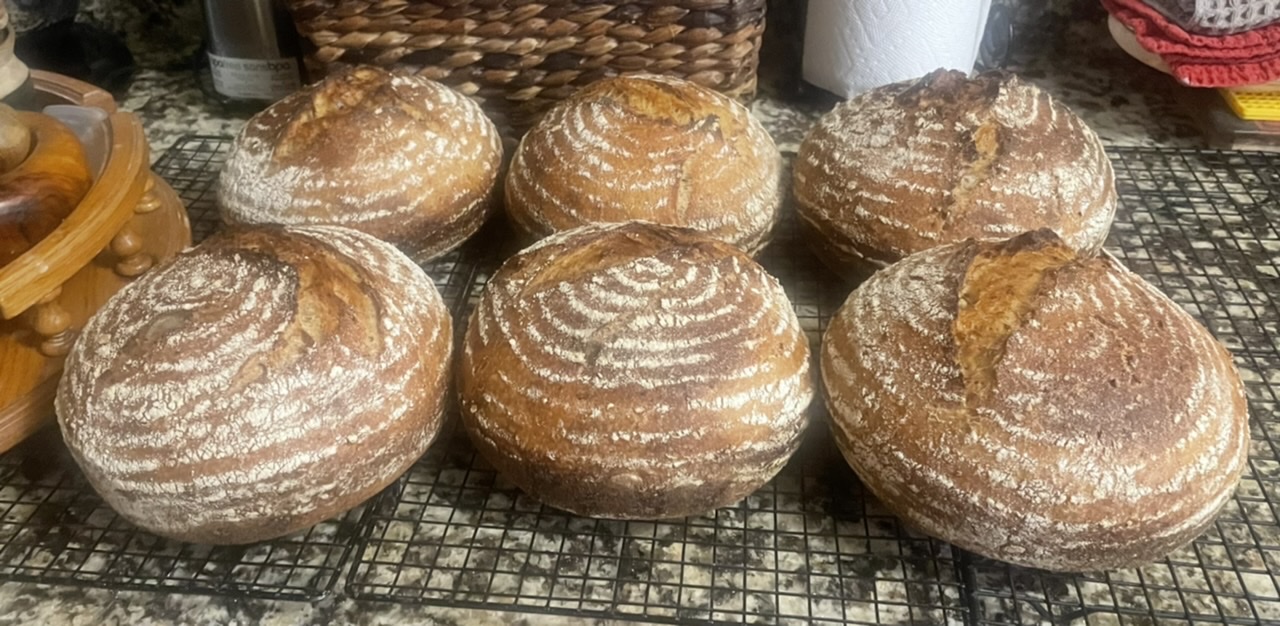I have a bucket of buckwheat groats that’s been sitting around for a bit. Time to use some up.
Recipe
Makes 3 loaves
Porridge
150 g buckwheat groats
400 g water
50 g honey
50 g butter
Dough
700 g strong bakers unbleached flour
200 g freshly milled whole grain Red Fife flour (200 g Red Fife berries)
100 g freshly milled whole grain Einkorn flour (100 g Einkorn berries)
675 g water
23 g salt
30 g yogurt
250 g levain (procedure in recipe)
Extra wholegrain flour of your choice and unbleached flour for feeding the levain
The night before:
1. Mill the grains and place in a tub. Add the unbleached flour to the tub as well. Cover and set aside.
2.Take 10 g of refrigerated starter and feed it 20 g of water and 20 g of wholegrain flour. Let that rise at cool room temperature for the night.
Dough Making day:
1. Early in the morning, feed the levain 100 g of filtered water and 50 g of strong baker’s flour and 50 g wholegrain flour. Let rise until doubled (about 5 hours).
2. About two hours before the levain is ready, put 675 g of water in a stand mixer’s bowl and add the flours from the tub. Mix on the lowest speed until all the flour has been hydrated. This takes a couple of minutes. Autolyse for a couple of hours at room temperature.
3. Toast the groats until golden. Place the groats in a pot with water. Bring to a boil, lower heat and cook until tender. This quick so watch the pot. Drain if there is extra water. Measure out 450 g of porridge. Add the butter and the honey and mix well. Set aside.
4. Once the autolyse is done and the levain has doubled, add the salt, the yogurt, the porridge, and the levain to the bowl. Mix on the lowest speed for a minute to integrate everything, then mix on the next speed for 9 minutes.
5. Remove the dough from the mixing bowl and place in a lightly oiled covered tub. Let rest 45 minutes in a warm spot (oven with light on).
6. Do 2 sets of coil folds at 45 minute intervals and then 2 more sets at 30 minutes intervals. Let rise about 30%. This dough was moving fast. I preshaped just a few minutes after the last fold.
7. Tip the dough out on a bare counter, sprinkle the top with flour and divide into portions of ~840g. Round out the portions into rounds with a dough scraper and let rest 30 minutes on the counter.
8. Do a final shape by flipping the rounds over on a lightly floured counter. Gently stretch the dough out into a circle. Pull and fold the third of the dough closest to you over the middle. Pull the right side and fold over the middle and do the same to the left. Fold the top end to the center patting out any cavities. Finally stretch the two top corners and cross over each other in the middle. Roll the bottom of the dough away from you until the seam is underneath the dough. Cup your hands around the dough and pull towards you, doing this on all sides of the dough to round it off. Finally spin the dough to make a nice tight boule.
9. Sprinkle a mix of rice flour and all purpose flour in the bannetons. Place the dough seam side down in the bannetons. Let rest for a few minutes on the counter and then put to bed in a cold (38F) fridge overnight.
Baking Day
1. The next morning, about 11 hours later, heat the oven to 475F with the Dutch ovens inside for 45 minutes to an hour. Turn out the dough seam side up onto a cornmeal sprinkled counter. Place rounds of parchment paper in the bottom of the pots, and carefully but quickly place the dough seam side up inside.
2. Cover the pots and bake the loaves at 450 F for 25 minutes, remove the lids, and bake for another 22 minutes at 425 F. Internal temperature should be 205 F or more.
